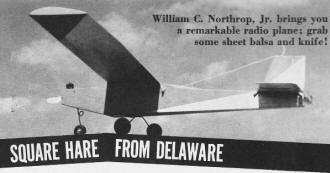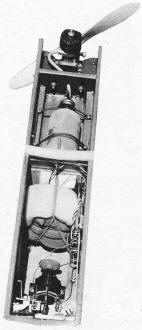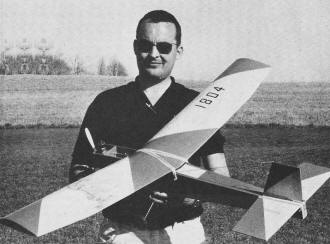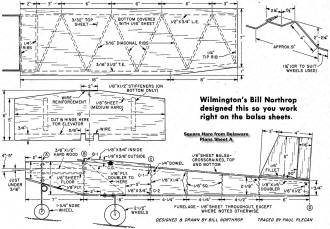|
Website visitor Steve R. wrote requesting that I scan and post this
article from the September 1962 issue of American Modeler magazine.
Says, Steve, "I built one of these back then on Galloping ghost
and it went great till servo failed (modified mighty Midget motor).
Later I built another for Class one Aerobatics fitted with OS 40
and Kraft Propo, this was very successful. Nostalgia strikes and
I'd like to build another as a sport model." Square Hare from Delaware
is a bit unique in that its wing has no spar and is constructed
from diagonally arranged ribs sandwiched between 3/32" balsa sheeting.
Looking at all the hardware required just for the elevator control
really makes you appreciate modern radio gear with servos. Hopefully,
Steve will grace us with a photo of his completed Square Hare.
Square Hare from Delaware
William C. Northrop, Jr. brings you a remarkable radio plane;
grab some sheet balsa and knife!

"Square Hare" was first sketched on the back of a specification
sheet for a pneumatic temperature transmitter ... which doesn't
prove anything except that we can't all be like Lincoln and carry
envelopes around with us.
 Main
reason for designing the plane was to carry experiments with the
sheeted-wing type construction beyond the 1/4A Lil Beau Bipe stage. Main
reason for designing the plane was to carry experiments with the
sheeted-wing type construction beyond the 1/4A Lil Beau Bipe stage.
Mascot sketch (left) is by Bob Lopshire. Northrop's
Square Hare has been duplicated with great success by many Eastern
radionauts of limited experience.
Idea was to create an R/C model without elaborate plans and using
wood sizes pretty much as they come from the store. Carrying this
to the limit, all lines were squared off as much as possible. Sorta
gives a continental look, don't it Henry?
The first Square Hare equipped with pulse rudder flew right off
the drawing board. (Next one will be built outside, we were lucky
the window was open that time.) Weight came out 44-oz, making loading
just a hare under 16-oz per sq ft. Maiden flight was without built-in
down-thrust shown and Mr. Hare just tilted to about 30° from
horizontal and sort of elevated himself almost straight up without
any forward motion. Just as the engine quit and I was expectantly
waiting to check the glide trim, the rudder came unhooked from the
torque rod (I know why, but I won't admit it even to my best friends).
So there I was at 500' with lots of rudder to the left and absolutely
none to the right. Rectangular Rabbit proved how rugged it is by
coming out of the clobber with only a broken nylon prop and Micarta
motor plate, plus a notch in the wing where the leading edge buried
itself in the engine cylinder head fins.
Subsequent tests resulted in reducing decalage to about 1°
positive, elimination of all but a smidgen of right thrust, and
fixing downthrust at 5°. These adjustments are on the plans.
Sometime later the Galloping-Ghost system was added which brings
us to its present form. Both plane and author have learned a lot
about flying since and Hare will now do spins, snap rolls, slow
rolls, loops, 5' off-the-deck buzz jobs, climbing victory rolls,
tail slides (down boy, I've got witnesses) and a few fantastic maneuvers
which cannot be described. It has survived four horrible crack-ups
(never mind about how many were P.E.), all in spite of the fact
that it has no fabric covering or fiberglass.
Probably the most surprising thing about the ship is its wide
range of suitability. I mean in the hands of a rank beginner it
has proved to be ideal with respect to stability, crash resistance,
and flying ease. When the experts get on the stick or start playing
with the panic buttons, it suddenly becomes, and has been called,
a Wild Hare. Expert proportional man Vince Bonnema of the NJRCC
flew the Hare in its rudder-only configuration at a DC/RC Symposium
and said, "It handles almost as good as my Rollo." (Brother, thar's
a compliment!)
Well, enough boasting, let's get with it.
Construction ... It's always hard to decide
how much detail to go into. Square Hare lends itself nicely to the
R/C beginner or even the completely inexperienced model builder.
Fuselage ... Select two straight, fairly hard
1/8" sheets for sides. Usually if you take two next to each other
in the dealer's rack they will be from the same log and have the
same bending strength and texture. This helps a great deal in getting
that top view alignment. Of course, if some other fussy modeler
was there first, it may take some time to find a matched pair, but
it's worth the trouble.
Lay out body sides on wood using a carpenter's square and soft
pencil or ball point pen. Draw in bulkhead positions. verticals,
doublers, motor mount beams. Cut sides and match them back to back
to check accuracy of your position markings. Cut 1/16" plywood doublers
using sides as pattern, glue in position. Of course, unless you're
using transparent plywood, this covers up the location of bulkheads
A & B and motor mount beams, which should be re-marked.
Double glue motor mount beams in place, followed by verticals,
wing and stab opening doublers, dowel gussets. Next, very accurately
cut cross grain 1/8" sheet floor that goes under beams and between
bulkheads A & B. This floor is the key to perfect alignment
of body sides and corners must be square. Now pour in the Ambroid
and assemble sides, using bulkheads A, B" C-1, C-2, and above mentioned
floor, double gluing all the way. Against fuselage sides, lay pencils
long enough to stick out beyond top and bottom at bulkheads A, B,
C and tightly wind rubber bands across ends. This will firmly clamp
assembly together while glue dries.
Before glue sets, check alignment once more by making sure that
ends meet evenly when pulled together at tail. If not, twist assembly
until tail ends line up without forcing. Add 3/32 plywood end plate
'D' which keys into notches formed by sides and 1/8 x 1/2 verticals
at tail. Last step before setting fuselage assembly aside to dry
is to insert 1/8 x 1/4 cross pieces at first station behind' 'C'.
Cut-and-try on these until sides, when pulled in to meet them, are
just about straight from station C to D.
When above assembly is dry, 1/8" cross-grain planking can be
applied to bottom, starting at rear and working forward to plywood
landing gear insert. It might be a good idea to bend 1/8" M.W. main
gear so it may be positioned and holes drilled for J-bolts before
plywood floor is glued into place.

Innards of the rectangular rabbit are viewed
If you're going to use a Mighty-Midget motor for pulse rudder
or Galloping-Ghost, ply floor also serves as a handy mounting spot
for motor, using 4-40 blind nuts pushed up from the bottom. Double
glue ply floor in place, pour in a big cement fillet on inside where
sides meet bottom. While that's setting up, let's get on with the
loop in the 1/8" M.W. nose wheel strut.
I'll explain my method of forming said loop. You'll need a heavy
vise, vise-grip pliers, a steel bar 3/8" in diameter.
The 1/8" M.W. and steel bar are clamped in vise together. M.W. is
placed horizontally, just flush with top of vise jaws, against rear
jaw, and with all but about 6" of wire sticking out to the right.
Bar is placed perpendicular to jaws and M.W., against front jaw,
near right end of vise.
Wilmington's Bill Northrop designed this so you work right on
the balsa sheets.
Using vise-grips, grab wire an inch beyond bar, holding vise-grips
as near parallel to wire as possible; slowly and carefully pull
wire around bar. Wire must just clear top of vise. After a 1/4 turn,
vise-grips will pull up against bar and you must release wire, slide
back an inch, grab again and continue pulling around. Watch carefully
where wire is clamped in vise to make sure it's not going to pop
out. You wind about a turn and a quarter to get one complete loop
since wire tends to open up a little, which is also why you must
use a steel bar smaller in diameter than loop you want. Don't give
up on the first try. I loused up about 4 or 5 before I got a good
one.
Assuming you got through that okay, bend rest of nose strut and
install on bulkhead A with 3 J-bolts. Finish planking bottom using
1/8 balsa and ply as shown. Fill space below engine beams in front
of bulkhead A with balsa block for additional strength and to eliminate
a fuel pocket.

Designer Bill with his Hare .
Install control system before closing top of body. If escapement,
reduce rudder width to 1" and put in 1/4" movement to each side.
You can leave it as is if you want, but an escapement version using
rudder shown with 3/8" movement stands right up on a wingtip when
button is pushed. Some G.G. installation suggestions are given on
the drawing, later in text. Complete body by adding 1/8 x 3/8 wing
rest pieces, forward 1/8" M.W. wing hook held with J-bolts, 1/4
balsa stiffener and filler B-1.
Empennage ... Construction of rudder and stabilizer
needs no description. Don't leave out wire reinforcement for rudder
bands or 1/4" diagonal fillets between fin and stab. Empennage may
be glued on, but evidence proves detachable one will last longer.
Wing ... Although wing construction is unique
to R/C, it is certainly nothing new. For a slight increase in weight,
it provides a sturdy and quickly-built structure which is impossible
to warp. For this reason a certain amount of care must be observed
during construction. If wing is built out of line it will remain
that way.
Start construction by butt-gluing two pieces of 3/32 x 4 medium
soft balsa together for each top surface panel. It's best to trim
joining edges with metal straight edge before gluing. Of course,
you may be able to find four equal grained pieces with well matched
edges at your hobby shop if you look long enough (your dealer's
going to love you when you get through with this one). Pin joined
surface to flat surface. While you're at it you might as well butt
glue 1/16 bottom planking, too. Prepare leading edges by beveling
1/2 x 3/4 hard balsa as shown. Best done on a table saw, this can
be planed down by hand. Next, glue leading and trailing edges to
underside of top panels being sure to cut 1" taper in tip first
and making certain you end up with one left and one right hand panel.
Cut all ribs using aluminum templates made from full size patterns.
One last step before actual assembly ... give underside of wing
panels two coats of dope. When you are ready to start, take phone
off hook and lock yourself in your room. This is one job you can't
stop in the middle. Wet top surface of one panel with water. Shortly,
wing will try to make itself into a tube. Fit, glue into place,
and pin, from the top, all ribs for one panel. Shorten tip ribs
to fit but don't trim them to fair into trailing edge now. Leave
out center rib. Pin whole structure to flat surface to dry. Repeat
with other panel.
Purpose of not tapering tip ribs is to keep top surface of wing
absolutely flat while drying. Later, when bottoms of these ribs
are tapered up to meet trailing edge you will automatically have
that important washout built into the wing tips. This also should
explain why you cannot build wing by starting with bottom sheet
and working up.
When the panels are dry (give them 12 hours at least) and removed
from the flat surface, try an experimental twist and you'll see
what I mean about warp-proof. Now block each panel tip up 3 inches,
sand in the dihedral bevel at the center (hand launch glider style),
and double-glue the two panels together. Add the 1/8" plywood dihedral
gussets and the center rib which has been shortened 1/8" at each
end. Finally, trim those tip ribs as mentioned before, then plank
bottom with previously prepared 1/16 sheet. After shaping, sanding,
filling and/or clear doping, and before covering (if used) wrap
3" band of Celastic or fiberglass around center section.
Finish ... the original Hare was given three
coats of filler made by adding talcum powder to thinned dope. This
was followed by the trim color (a metallic copper, made from orange
and silver with a dash of yellow) and two coats of clear. All butyrate.
No silk or nylon covering was used, although there's no denying
Rugged Rabbit would be stronger for it, albeit heavier.
If you want the S.H. insignia on the wing, trace and transfer
it to the wing with carbon paper; use a glass-marking pencil (such
as Stabilo) to finish the job. Protect with clear dope.
Special Notes on Galloping Ghost R/C Installation
G.G. installation ... The small amount of down
in relation to up elevator requires fast pulsing to get level fight.
This almost completely eliminates gallop even in full up.
Bind with string or glue with Walther's Goo the M.M. motor brushes
to motor body. Engine vibration will loosen these eventually. Don't
wait until you develop a 50' outside loop from 25' to follow this
suggestion. Don't forget the .01 condenser across the M.M. brush
contacts. Glue this to the floor with contact cement to prevent
vibration from fatiguing the leads.
Install hardwood bearing halfway between M.M. and tail-plate
D to prevent whipping and subsequent vibration-binding of torque
rod. A 3/32" bearing hole is big enough to restrict whipping without
creating a bind.
If you're a newcomer to G.G., adjust Center of Gravity 3/8" ahead
of where shown to tame-down the Hare's reactions to stick movement.
When you are ready to shoot the works, add weight to the tail until
Center of Gravity is as shown or even back another 1/4". The Hare
will do a 2-1/2 turn snap roll followed by a spin if you snap the
stick back first and then hit a panic button (full-off or full-on).

Square Hare from Delaware Plans Sheet A

Square Hare from Delaware Plans Sheet B

Square Hare from Delaware Plans Sheet C

Square Hare from Delaware Plans Sheet D
Notice:
The AMA Plans Service offers a
full-size version of many of the plans show here at a very reasonable cost. They
will scale the plans any size for you. It is always best to buy printed plans because
my scanner versions often have distortions that can cause parts to fit poorly. Purchasing
plans also help to support the operation of the
Academy of Model Aeronautics - the #1
advocate for model aviation throughout the world. If the AMA no longer has this
plan on file, I will be glad to send you my higher resolution version.
Try my Scale Calculator for
Model Airplane Plans.
Posted January 4, 2016
|